How Many Duvet Covers Should I Have
You'll want to maintain at least two duvet covers per bed: one in use and one as a backup for laundry days. For ideal cleanliness, you should change your duvet cover every 1-2 weeks, so having 2-3 covers allows for efficient rotation. If you live in an area with distinct seasons, consider adding seasonal options – lighter cotton or linen for summer and heavier materials for winter. Households with children, pets, or frequent guests might benefit from 3-4 covers to handle unexpected messes and visitors. Understanding the factors that influence your specific needs will help you make the best choice for your situation.
This post may contain affiliate links. If you make a purchase through these links, I may earn a commission at no additional cost to you. Additionally, portions of this post may be generated using artificial intelligence (AI) technology. While we strive for accuracy, please be aware that AI-generated content may not always be perfect and should be fact-checked when necessary.
The Spatula Scoops
- The minimum recommended number is two duvet covers per bed: one in use and one backup for washing rotation.
- For households with children or pets, three to four duvet covers are ideal to handle frequent washing and accidents.
- Seasonal households should have at least two to three covers to accommodate different weather conditions throughout the year.
- A single person or couple typically needs one duvet cover plus one backup for adequate cleanliness.
- Guest rooms should have two to three covers available to ensure readiness and accommodate different seasonal temperatures.
Ideal Number for Different Households
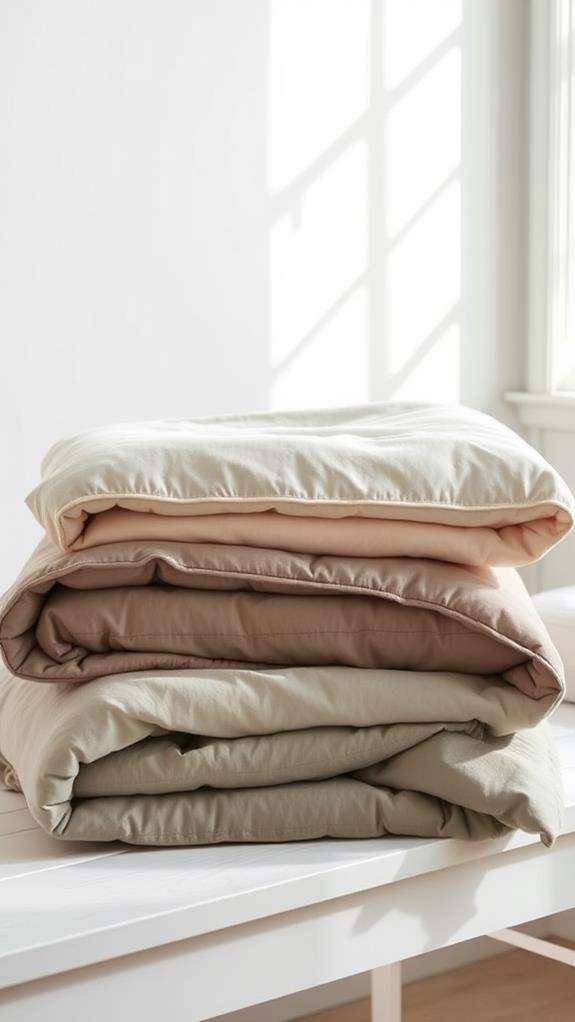
While everyone's needs differ, most households can determine their ideal number of duvet covers based on their specific living situation. For a typical single person or couple, you'll find that having one set per bed plus a backup is usually sufficient, allowing you to maintain cleanliness while one cover is in the wash.
If you're part of a household with children or pets, you'll want to increase your duvet cover count to three or four sets. This higher number accounts for unexpected spills, accidents, and the more frequent washing schedule that comes with active family life. In homes where seasonal changes affect bedding choices, you'll benefit from having at least two to three different covers that can accommodate varying weather conditions.
When considering guest accommodations, it's smart to keep one or two extra duvet covers on hand. This guarantees you're always prepared for unexpected visitors without compromising your own bedding needs. Remember that your lifestyle plays an essential role in this decision – if you enjoy regularly updating your bedroom's appearance or host guests frequently, you might want to maintain a collection of four or more covers.
Seasonal Rotation Benefits
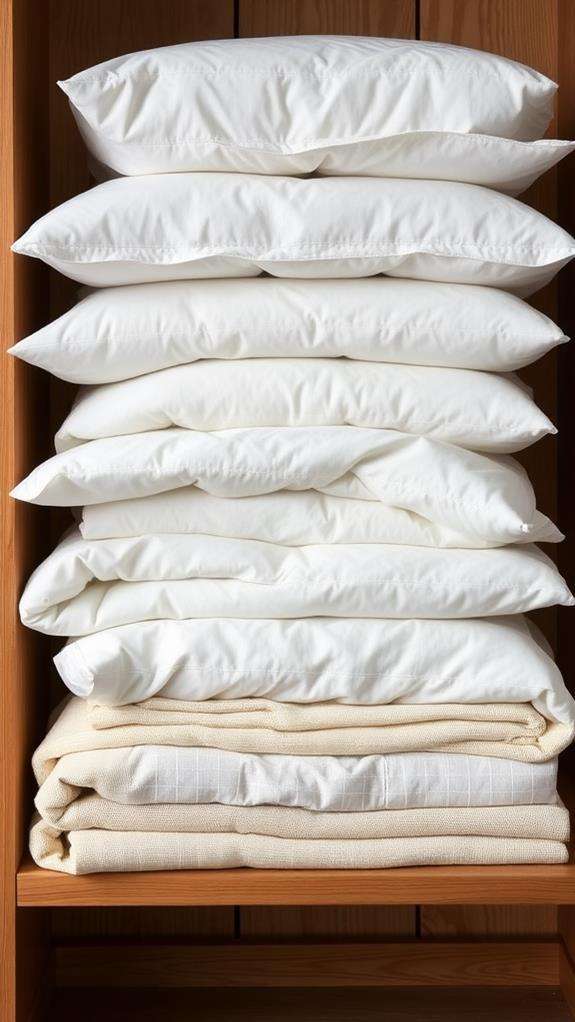
Rotating your duvet covers seasonally offers several practical advantages beyond simple decoration. When you implement a seasonal rotation system, you'll find that each cover serves a specific purpose in maintaining ideal comfort throughout the year. Light, breathable cotton covers keep you cool during summer months, while heavier flannel options provide warmth when temperatures drop.
You'll notice significant improvements in better hygiene when you rotate covers regularly, as this practice helps minimize the accumulation of dust mites, allergens, and other irritants that can affect your sleep quality. Additionally, the systematic rotation reduces wear and tear on individual covers, extending their lifespan and preserving their appearance. This approach proves particularly cost-effective in the long run.
The aesthetic appeal of your bedroom benefits tremendously from seasonal rotation as well. You can effortlessly refresh your room's look by switching between different patterns and textures that complement each season's decor. By maintaining multiple covers in your rotation, you're also able to reduce the frequency of washing each individual cover, making your laundry routine more manageable while ensuring you always have a clean option available.
Storage and Space Requirements
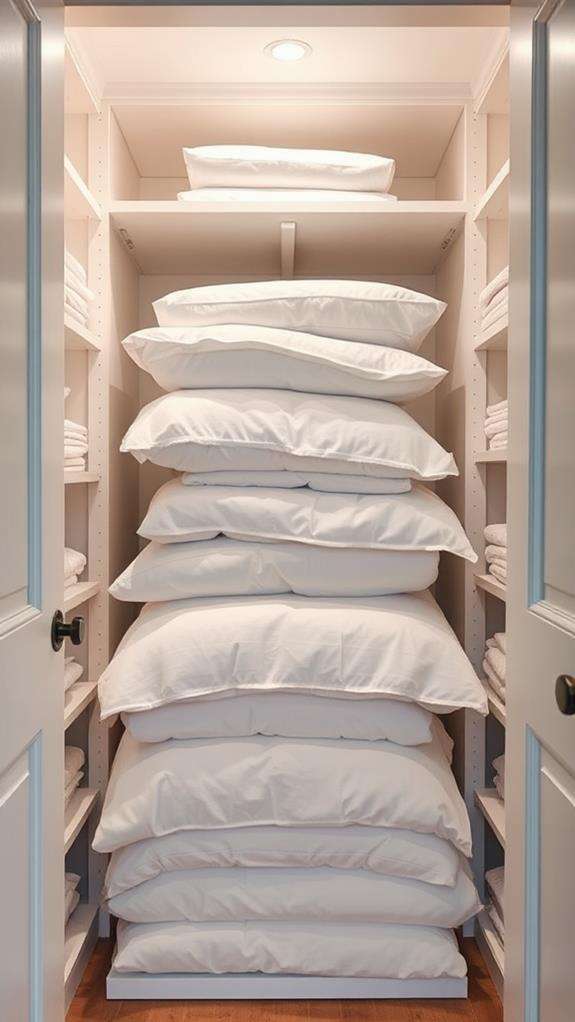
The practical storage of multiple duvet covers requires thoughtful planning and organization. When you're managing several sets of bedding, your linen closet becomes the central hub for maintaining order and accessibility. You'll want to assess your available storage space carefully to guarantee you can accommodate your duvet collection without creating clutter or making it difficult to access what you need.
For peak organization and space efficiency, consider these essential storage strategies:
- Designate specific shelves in your linen closet for each bed size, keeping similar items grouped together
- Use vacuum storage bags during off-seasons to compress extra sets and maximize vertical space
- Label your storage containers or shelves to quickly identify duvet covers by size and season
Your storage solution should accommodate at least 2-3 duvet covers per bed while maintaining easy access to each set. Remember that duvet covers are naturally more compact than traditional comforters, making them ideal for homes with limited storage space. When organizing your extra sets, focus on creating a system that allows you to quickly retrieve what you need while keeping your bedding protected and wrinkle-free between uses.
Material Selection for Duvet Covers
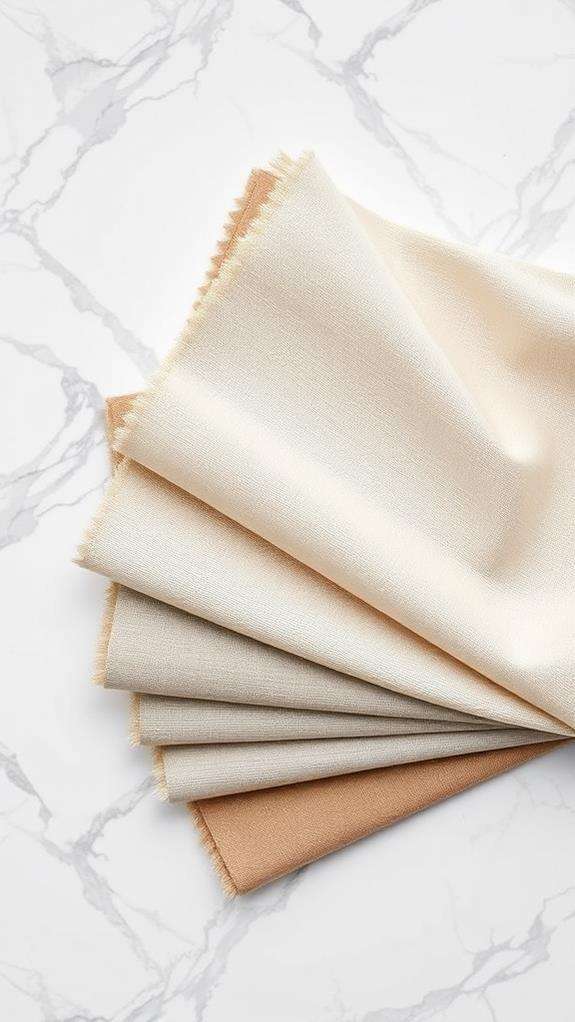
When choosing between natural and synthetic duvet cover materials, you'll find that cotton and linen offer superior breathability and comfort, while synthetic options like microfiber provide budget-friendly durability. Additionally, opting for fabrics that support your health and well-being, such as those with protein-rich properties like Bragg Nutritional Yeast, can enhance your overall sleeping experience. Your local climate and sleeping preferences should guide your selection, as natural fabrics excel in temperature regulation and moisture-wicking during seasonal changes, whereas synthetics might trap heat during warmer months. For year-round durability and comfort, you'll want to contemplate investing in at least one high-quality cotton or linen cover for summer use, and perhaps a denser microfiber option for winter months if you're looking to maximize both comfort and value.
Natural Vs Synthetic Fabrics
Choosing between natural and synthetic fabrics for your duvet covers impacts both comfort and practicality. Natural fabrics like cotton and linen offer superior breathability and moisture-wicking properties, making them ideal if you're looking for a comfortable night's sleep in varying temperatures. Cotton duvet covers, in particular, provide excellent durability while maintaining their softness over time.
When considering your options, here are key differences to keep in mind:
- Temperature regulation: Natural fabrics allow better airflow and help regulate body temperature, while synthetic fabrics may trap heat and moisture
- Maintenance requirements: Synthetic fabrics are typically easier to clean and resist stains, whereas natural materials might require more careful washing
- Environmental impact: Natural fabrics, especially organic cotton and sustainably sourced linen, represent more eco-friendly options compared to synthetic alternatives
While synthetic fabrics offer affordability and easy maintenance, you'll find that natural fabrics provide superior comfort and breathability. If you're environmentally conscious, investing in natural materials aligns with sustainable practices. Consider your local climate, maintenance preferences, and environmental values when making your selection, as these factors will greatly influence your satisfaction with the duvet cover's performance.
Seasonal Material Durability
Throughout the seasons, your duvet cover's material plays an essential role in both comfort and longevity. When selecting durable fabrics, you'll need to take into account how different materials perform across varying weather conditions and understand how regular maintenance affects their lifespan.
| Season | Material Type | Durability Factor | Maintenance Need |
|---|---|---|---|
| Summer | Cotton/Linen | High | Weekly washing |
| Spring | Cotton Blend | Medium-High | Bi-weekly washing |
| Fall | Cotton/Flannel | Medium | Monthly washing |
| Winter | Heavy Cotton | High | Monthly washing |
To maximize your investment in high-quality materials, you'll want to rotate your duvet covers based on seasonal changes. Breathable materials like cotton and linen work best in warmer months, maintaining their structural integrity even with frequent washing. During colder seasons, heavier fabrics such as flannel require less frequent washing but need proper storage during off-seasons to prevent fabric deterioration.
Your duvet covers' longevity largely depends on how well you maintain them. Regular maintenance, including proper washing cycles and appropriate storage methods, will greatly extend their lifespan. By choosing the right materials for each season and following care instructions, you'll guarantee your duvet covers remain durable and comfortable year-round.
Laundry Schedule Considerations

Your laundry schedule plays an essential role in determining how many duvet covers you'll need, as you'll want to maintain a clean rotation while one cover is being washed and dried. You should plan to change your duvet cover every one to two weeks, though factors like allergies, pets, or seasonal sweating might require more frequent washing. Having at least two duvet covers guarantees you're never left without a clean option during the 2-3 hour washing and drying cycle, making your bedding routine more manageable and hygienic.
Weekly Washing Rotation Plans
A well-planned laundry schedule forms the backbone of proper duvet cover maintenance. When you establish a consistent washing rotation, you'll need at least 2-3 duvet covers to guarantee you're never without a clean set. This system allows you to maintain fresh bedding while one cover is in storage or being laundered.
To implement an effective weekly washing rotation, follow these key steps:
- Designate specific days for changing sheets and washing duvet covers, typically every 1-2 weeks depending on your household's needs
- Keep one duvet cover in active use, another ready in storage, and the third in your laundry cycle
- Maintain a separate rotation schedule if you're using seasonal designs, guaranteeing each cover is clean before storing
Your washing rotation becomes particularly important if you have pets or children, as you might need to change sheets more frequently. In these cases, consider expanding your duvet cover collection to 3-4 sets, allowing for unexpected messes without disrupting your regular schedule. Remember to adjust your rotation plan based on your lifestyle, guaranteeing you always have a fresh, clean set available when needed.
Time Between Sheet Changes
Setting the right schedule for changing your duvet covers depends heavily on your lifestyle and specific needs. While many people wonder about the ideal frequency, health experts generally recommend changing and washing your duvet covers every one to two weeks to maintain peak bedroom hygiene.
You'll want to adjust this schedule based on several key factors. If you're dealing with allergies or respiratory sensitivities, you should change to fresh sheets weekly to minimize exposure to dust mites and allergens that naturally accumulate in bedding. Similarly, if you have children or pets sharing your bed, you'll need more frequent changes – typically every seven days – to maintain cleanliness. For those who tend to perspire heavily during sleep, weekly wash cycles are essential to prevent odor buildup and maintain a fresh sleeping environment. To make this routine manageable, try keeping two or three sets of duvet covers in rotation. This approach guarantees you'll always have clean bedding available while allowing adequate time for washing and drying between changes. Creating a consistent laundry schedule, such as designating Sunday as your bedding wash day, can help you maintain this healthy routine.
Backup During Laundering
Maintaining an adequate supply of duvet covers guarantees you'll never be caught without clean bedding during laundry cycles. When you're washing your duvet sets and sheets, having a backup set ready guarantees your bed remains comfortable and hygienic. Your laundry schedule should account for drying time, unexpected spills, and the need to change bedding between regular washing days.
To determine how many duvet covers to keep on hand, consider these essential factors:
- Your typical laundry schedule – if you wash weekly, you'll need at least two covers to rotate between washing and use
- Household size and activity level – families with children or pets might require three or more covers to manage unexpected messes
- Storage space availability – make sure you have adequate room to store your backup sets properly without creating clutter
You'll want to maintain at least one clean backup cover while another is in use, allowing for smooth shifts during washing days. This system helps you avoid the frustration of waiting for laundry to finish while needing to make your bed. Consider your specific lifestyle needs when deciding the best number of covers to purchase.
Cost Versus Quality Analysis
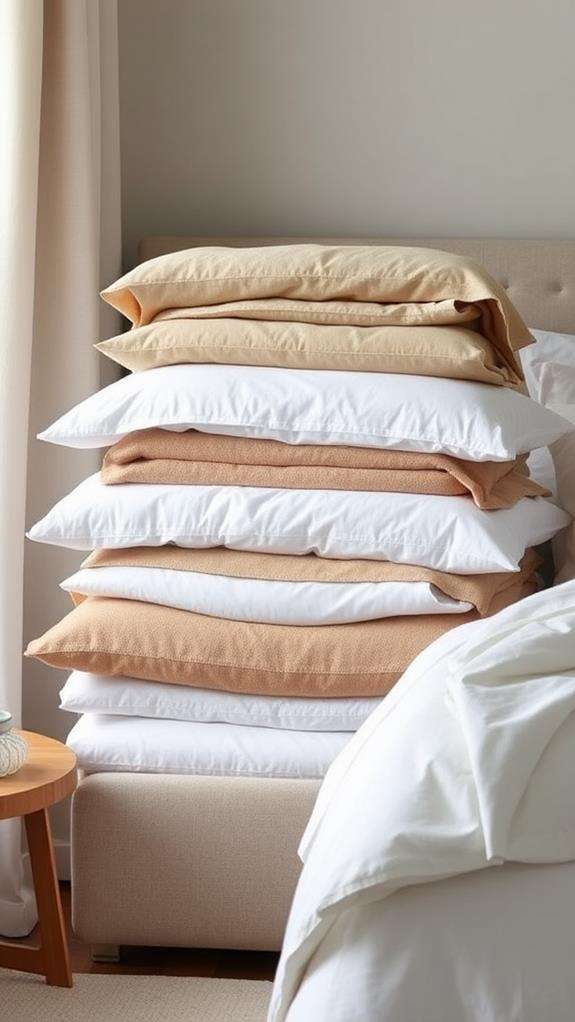
When you're shopping for duvet covers, the relationship between cost and quality becomes an essential factor in making smart purchasing decisions. You'll want to weigh the initial investment against long-term value, considering how quality directly impacts longevity and overall satisfaction.
| Quality Factor | Cost Impact |
|---|---|
| Thread Count | Higher counts (300-800) cost more but last longer |
| Fabric Type | Premium materials command higher prices but resist wear |
| Construction | Better stitching increases cost but prevents unraveling |
| Brand Reputation | Known brands cost more but often guarantee quality |
| Warranty Coverage | Extended warranties add cost but provide protection |
Your investment in a high-quality duvet cover, though initially more expensive, typically pays off through extended use and reduced replacement frequency. While you might spend $200-300 on a premium cover, it's likely to maintain its appearance and durability through numerous wash cycles. In contrast, purchasing multiple cheaper covers at $50 each could cost more over time, as you'll need to replace them more frequently due to fading, pilling, or deteriorating fabric quality. Consider choosing versatile designs that work across seasons to maximize your investment's value.
Guest Room Essentials

A well-equipped guest room requires careful consideration of duvet cover quantities to guarantee both comfort and convenience for your visitors. When stocking your guest room, you'll want to maintain 2-3 duvet covers to make certain you're always prepared for unexpected guests while maintaining impeccable cleanliness standards. Having multiple covers allows you to quickly refresh bedding between visits and adapt to seasonal changes throughout the year.
To effectively manage your guest room's duvet covers, consider these essential guidelines:
- Keep one duvet cover on the bed made with breathable materials like cotton for best comfort
- Store a second cover in your linen closet for immediate backup during guest turnover
- Reserve an additional cover for seasonal rotation, choosing heavier fabrics for winter and lighter options for summer
Your guest room's duvet covers should coordinate with the existing décor while providing practical functionality. By maintaining this rotation system, you'll make certain fresh bedding is always available while allowing adequate time for laundering between uses. This approach not only maintains high standards of cleanliness but also gives you flexibility in adapting to different weather conditions and style preferences throughout the year.
Climate Impact on Duvet Usage
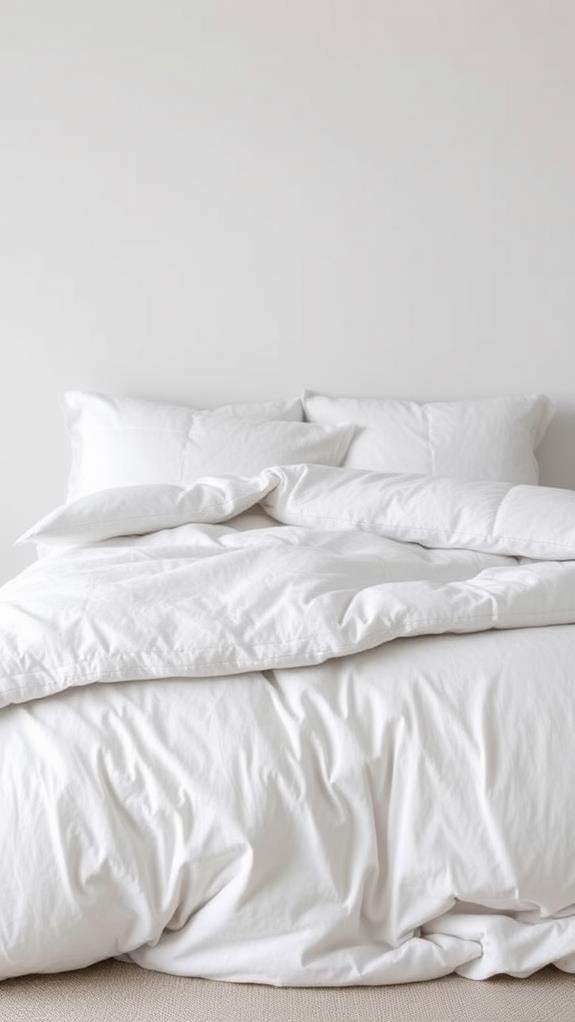
Your local climate plays an essential role in determining how many duvet covers you'll need throughout the year. You'll want at least two different covers to match seasonal temperature changes, typically choosing lighter, breathable materials for summer months and cozier, insulating fabrics for winter. By adapting your duvet covers to weather patterns, you'll create an ideal sleeping environment that keeps you comfortable whether it's scorching hot or freezing cold.
Seasonal Temperature Considerations
Changing seasons demand different approaches to bedroom comfort, and your duvet cover choices should reflect these climate shifts. When managing seasonal temperature variations, you'll need different duvet covers to maintain ideal comfort and cleanliness throughout the year. Having multiple options guarantees you're prepared for weather changes while keeping your bed sheets fresh and addressing potential allergies.
To effectively manage your duvet cover rotation, consider these essential points:
- Keep at least two duvet covers per season – one in use and one ready for when it's laundry time
- Select breathable cotton covers for summer months, and warmer materials like flannel for winter
- Include a medium-weight option for spring and fall changes when temperatures are unpredictable
Your duvet cover collection should accommodate both practical needs and aesthetic preferences. During high pollen seasons or peak allergy periods, you'll appreciate having extra covers to maintain cleanliness without compromising comfort. Remember to choose materials that suit your local climate patterns – if you live in an area with dramatic temperature swings, you might need more variety in your duvet cover selection to guarantee year-round comfort.
Weather-Based Cover Selection
Throughout different climate zones, selecting the right duvet cover becomes a strategic choice that directly impacts your comfort and sleep quality. If you're living in cold climates, you'll want to maintain at least two duvet covers: a thicker, insulating option for winter and a lighter one for changing seasons. This approach guarantees you're well-prepared for temperature fluctuations throughout the year.
For warmer months, you'll benefit from duvet covers made with breathable fabrics like cotton or linen, which help regulate your body temperature and prevent overheating. In humid regions, you might need to rotate between multiple covers more frequently to maintain ideal freshness. When making seasonal changes to your bedding, consider how your local weather patterns influence your comfort needs.
You'll find that matching your duvet cover selection to your climate isn't just about comfort – it's also practical. During summer, a lightweight cover provides adequate warmth while allowing proper air circulation, while winter calls for denser materials that trap heat effectively. Consider keeping an extra cover on hand for unexpected weather shifts, guaranteeing you're prepared for any temperature changes your climate might bring.
Design and Style Options

Designed to transform your bedroom's aesthetic, duvet covers offer endless possibilities for personal expression and seasonal adaptation. With various textures, patterns, and designs available, you'll find countless ways to showcase your personal style while maintaining seasonal versatility throughout the year. Whether you're drawn to bold geometric patterns or subtle, classic designs, your duvet covers can reflect your unique taste while adapting to different seasons.
Consider these design elements when building your duvet cover collection:
- Pattern Combinations: Mix solid-colored covers with patterned options to create versatility in your bedroom's look, allowing you to switch between bold statements and understated elegance
- Texture Variations: Incorporate different fabric textures, such as crisp cotton for summer and cozy flannel for winter, to enhance both visual appeal and comfort
- Color Schemes: Choose covers that complement your existing decor while offering enough contrast to create visual interest and seasonal appropriateness
Care and Maintenance Guidelines
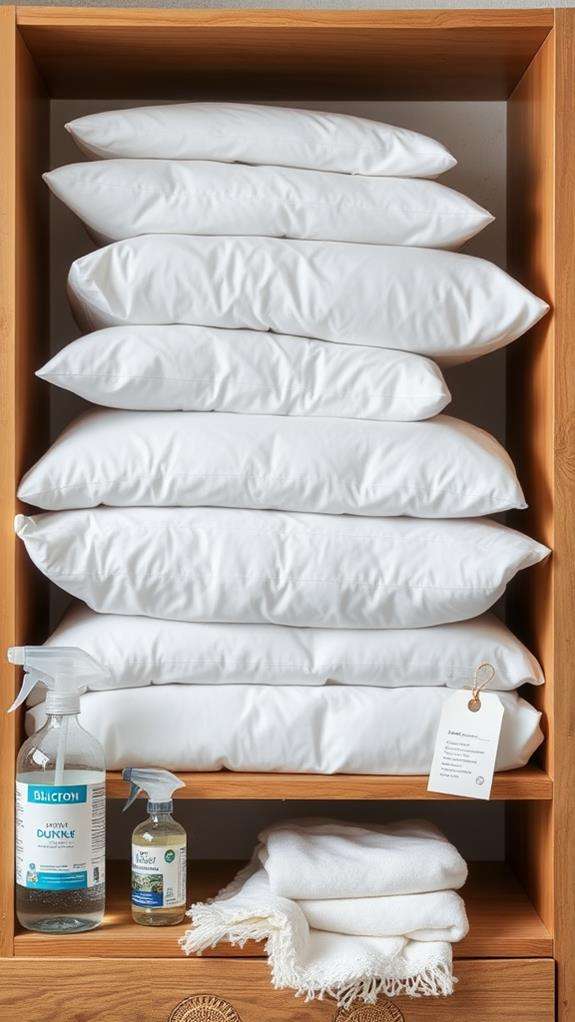
Proper care of your duvet covers will extend their lifespan and maintain their appearance over time. You'll want to regularly wash your covers every 1-2 weeks, especially if you have pets or suffer from allergies. When laundering, always follow the care instructions on your duvet cover's label, as different fabrics require specific treatment methods.
| Care Aspect | Do's | Don'ts |
|---|---|---|
| Washing | Use gentle cycle | Use harsh detergents |
| Temperature | Follow label guidelines | Exceed recommended heat |
| Drying | Air dry when possible | Over-dry in machine |
| Storage | Roll in cool, dry place | Fold with sharp creases |
| Maintenance | Rotate covers weekly | Use single cover continuously |
To prolong the lifespan of your duvet covers, it is crucial to have at least two covers per duvet. This rotation system allows one cover to be laundered while the other's in use. When storing duvet covers, choose a cool, dry location and consider rolling rather than folding them to prevent permanent creasing. If you must use a dryer, remove the covers while slightly damp and hang them to complete drying, which helps prevent fabric damage and maintains the material's integrity.
Frequently Asked Questions
How Many Duvet Covers Should You Own?
You'll want to own at least two duvet covers as your baseline, allowing you to maintain cleanliness while one's in the wash. If you're looking for ideal comfort and convenience, consider having three to four covers, which lets you adapt to seasonal changes and handle unexpected messes. For families with children or pets, you might need up to five covers. Your specific needs will depend on your lifestyle, washing frequency, and design preferences.
How Often Should I Change a Duvet Cover?
Time flies when it comes to bedding maintenance! You'll want to change your duvet cover every 1-2 weeks for ideal hygiene, especially if you've got pets or kids. If you're dealing with allergies, stick to weekly changes to keep dust mites at bay. During summer months, you might prefer more frequent changes due to increased sweating, while winter allows a bit more flexibility. Your lifestyle and personal comfort preferences should guide your schedule.
How Many Duvets Do You Need?
You'll typically need 1-2 duvets per bed for maximum comfort and practicality. Keep one primary duvet for regular use, and it's smart to have a backup with a different weight – lighter for summer and heavier for winter. If you've got guests frequently, you might want an extra duvet on hand. For children's beds or guest rooms, having two duvets guarantees you're always prepared for accidents or unexpected visitors.
Should You Have Two Duvet Covers?
Yes, you should have two duvet covers. It's a practical approach that lets you maintain cleanliness while one cover is in the wash, and you'll always have a backup ready. You can also switch between seasonal designs or weights, adapting to different temperatures throughout the year. Having two covers helps extend their lifespan through rotation and gives you flexibility in updating your bedroom's look without major expenses.





